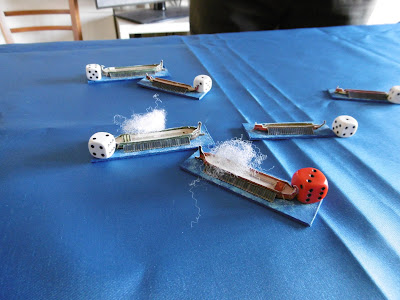"Livius indignatione accensus praetoria nave in hostes tendit, [...] demittere remos in aquam ab ustroque latere remiges stabiliendae navis causa iussit, et in advenientis hostium naves ferreras manus inicerre et, ubi pugnam pedestri similem fecissent, meminisse Romae virtutis nec pro viris ducere regia manicipa."
"Livius, inflamed with passion, made for the enemy with the flagship, [...] he ordered the rowers on both sides to trail their oars in the water to steady the ship and the men to throw iron grappling-hooks upon the approaching hostile ships, and when they had made the engagement like one on land, he bade them remember Roman valour and not to consider the king's salves as men."
Titus Livius, Ab Urbe Condita, XXXVI, XLIV, VII-VIII.
Welcome to the first outing of our ancient galleys, this battle is part of our "Romano-Syrian war" campaign: the romans won the first bout at the Termopylae, will the seleucid be able to stop the enemy fleet on its tracks and prevent the legions from passing to Asia?
The romans are led by the praefectus Caius Livius Salinator (red dice), who, not familiar with naval affairs, finds himself still in a sailing column against an enemy fleet deployed in combat line. The romano-rhodian fleet is composed by a motley crew of quinquerremes, monoremes and trirremes.
Aboard his over the top deceres, the seleucid admiral Polixenidas, has an easy job ahead of him with his monorreme and quinquerreme fleet in an ideal position.
The romans begin to form a line turning the heavy ships in a right angle while the faster monoremes rush to the right
The seleucid inaction benefits the allies, giving them plenty of time to form the battleline
As the romans begin to advance the seleucid react
And Livius's ship is set on fire by the deceres!
The lines clash
The prefect crashes his ship against a five that he had previously set on fire, stripping two damage
The fire eats away at the damaged ships
Ineffective seleucid ramming
Seeing the chance, a roman five rams an enemy monoreme
Sending it to the bottom! First blood to Livy
A rhodian trirreme also sinks a bigger quinquerreme with a single hit, proving the superior seamanship of the islanders
A monoreme fails tough
The allies have the left and begin to press on the center and the enemy flagship
The praetorian galley is in bad shape but still stands firm
The five facing the prefect retreats but the fire burns it down
The monoreme that had just rammed the roman flagship is rushed by a bigger five and sunk
Another seleucid five tries to board Livius but he takes the enemy ship instead
However roman steel is no proof against fire and the flagship becomes a burning wreck
Polixenidas orders the retreat of his remaining galleys while the victorious roman pursue
In the last turn the seleucid try some desperate boarding, killing one monoreme.
The battle has been a clear victory for the romans 15-6, the brave sacrifice of the prefect, who took no less than two fives down with him cast a mournfoul veil over his complete sucess.
With this the romans have two campaign points, once they reach four the seleucids'll have one unit less in the final battle: Magnesia.
We played using my rulebook corona navalis I liked how it played out, but as always my father complainded: this time it was too simple and kiddish, so next time we'll give Fleet of Battle a try. He'll see what is to play with a truly complex rulebook: I can already hear his complaints about it being too comlpicated ;).
Til then SALVE ATQUE VALE





















































